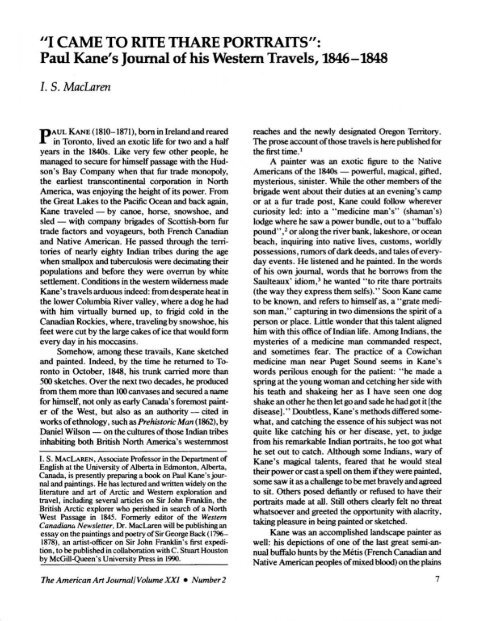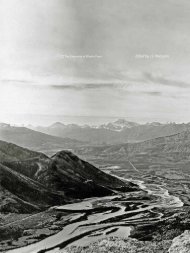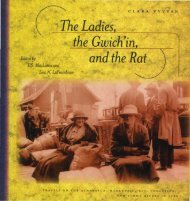Paul Kane's Journal of his Western Travels, 1846-1848 - History and ...
Paul Kane's Journal of his Western Travels, 1846-1848 - History and ...
Paul Kane's Journal of his Western Travels, 1846-1848 - History and ...
You also want an ePaper? Increase the reach of your titles
YUMPU automatically turns print PDFs into web optimized ePapers that Google loves.
III CAME TO RITE THARE PORTRAITS":<br />
<strong>Paul</strong> <strong>Kane's</strong> <strong>Journal</strong> <strong>of</strong> <strong>his</strong> <strong>Western</strong> <strong>Travels</strong>, <strong>1846</strong>-<strong>1848</strong><br />
I. S. MacLaren<br />
PAU KAN (1810-1871), born in Irel<strong>and</strong> <strong>and</strong> reared<br />
in Toronto, lived an exotic life for two <strong>and</strong> a half<br />
years in the 18405. ike very few other people, he<br />
managed to ecure for himself passage with the Hud·<br />
son's Bay Company when that fur trade monopoly,<br />
the earliest transcontinental corporation in North<br />
America, was enjoying the height <strong>of</strong> its power. From<br />
the Great Lakes to the Pacific Ocean <strong>and</strong> back again<br />
Kane traveled - by canoe, horse, snowshoe <strong>and</strong><br />
sled - with company brigades <strong>of</strong> Scottish-bom fur<br />
trade factors <strong>and</strong> voyageurs, both French Canadian<br />
<strong>and</strong> Native American. He passed through the tenitories<br />
<strong>of</strong> nearly eighty Indian tribes during the age<br />
when smallpox <strong>and</strong> tuberculosis were decimating their<br />
populations <strong>and</strong> before they were overrun by white<br />
settlement. Condition in the we tern wilderness made<br />
<strong>Kane's</strong> travels arduous indeed: from desperate heat in<br />
the lower Columbia River valley, where a dog he had<br />
with him virtually burned up, to frigid cold in the<br />
Canadian Rockies, where, traveling by snowshoe, <strong>his</strong><br />
feet were cut by the large cakes <strong>of</strong> ice that would fonn<br />
every day in <strong>his</strong> moccasins.<br />
Somehow, among these travails, Kane ketched<br />
<strong>and</strong> painted. Indeed, by the time he returned to Toronto<br />
in October, <strong>1848</strong>, <strong>his</strong> trunk carried more than<br />
500 sketches. Over the next two decades, he produced<br />
from them more than 100 canvases <strong>and</strong> secured a name<br />
for himself, not only as early Canada's foremo t painter<br />
<strong>of</strong> the West, but also as an authority - cited in<br />
works <strong>of</strong> ethnology, such as Pre<strong>his</strong>toric Man (1862), by<br />
Daniel Wilson - on the cultures' <strong>of</strong> those Indian tribes<br />
inhabiting both British North America's westernmost<br />
I. S. MACLAREN , Associate Pr<strong>of</strong>essor in the Department <strong>of</strong><br />
English at the University <strong>of</strong> Alberta in Edmonton. A1berta,<br />
Canada, is presently preparing a book on <strong>Paul</strong> <strong>Kane's</strong> journal<br />
<strong>and</strong> paintings. He has lectured <strong>and</strong> written widely on the<br />
literature <strong>and</strong> art <strong>of</strong> Arctic <strong>and</strong> <strong>Western</strong> exploration <strong>and</strong><br />
travel, including several articles on Sir John Franklin. the<br />
British Arctic explorer who perished in search <strong>of</strong> a North<br />
West Passage in 1845. Formerly editor <strong>of</strong> the <strong>Western</strong><br />
Canadianu Newsletter, Dr. MacLaren will be publishing an<br />
essay on the paintings <strong>and</strong> poetry <strong>of</strong> Sir George Back (1796-<br />
1878), an artist-<strong>of</strong>ficer on Sir John Franklin's first expedition,<br />
to be published in coUaboration with C. Stuart Houston<br />
by McGilJ-Queen's University Press in 1990.<br />
The American Art <strong>Journal</strong>/Volume XXI • Number 2<br />
reache <strong>and</strong> the newly de ignated Oregon Territory.<br />
The prose account <strong>of</strong> th travel i here published ~ r<br />
the first time. I<br />
A painter was an exotic figure to the alive<br />
American <strong>of</strong> the 18405 - powerful, magical, gifted,<br />
mysterious, sini ter. While the other members <strong>of</strong> the<br />
brigade went about their duties at an evening's camp<br />
or at a fur trade po t, Kane could follow wherever<br />
curio ity led: into a "medicine man's" (shaman's)<br />
lodge where he saw a power bundle, out to a • buffalo<br />
pound" , 2 or along the river bank lakeshore or ocean<br />
beach, inquiring into native lives, customs, worldly<br />
posse sion ,rumors <strong>of</strong> dark deed ,<strong>and</strong> tale <strong>of</strong> everyday<br />
events. He Ii tened <strong>and</strong> he pamted. In the word<br />
<strong>of</strong> hi own journal, words that he borrows from the<br />
Saulteaux' idiom 3 he wanted to rite thare portraits<br />
(the way they express them self ).' Soon Kane came<br />
to be known, <strong>and</strong> refers to himself as a' grate medison<br />
man, " capturing in two dimensions the pirit <strong>of</strong>a<br />
person or place. Little wonder that t<strong>his</strong> talent aligned<br />
him with t<strong>his</strong> <strong>of</strong>fice <strong>of</strong> Indian life. Among Indians, the<br />
mysteries <strong>of</strong> a medicine man comm<strong>and</strong>ed respect,<br />
<strong>and</strong> sometimes fear. The practice <strong>of</strong> a Cowichan<br />
medicine man near Puget Sound seems in Kane'<br />
words perilous enough for the patient: 'he made a<br />
spring at the young woman <strong>and</strong> cetching her ide with<br />
<strong>his</strong> teath <strong>and</strong> shakeing her as I have en one dog<br />
shake an other he then let go <strong>and</strong> sade he had got it [the<br />
disease]." Doubtless <strong>Kane's</strong> methods differed somewhat,<br />
<strong>and</strong> catching the essence <strong>of</strong> <strong>his</strong> subject was not<br />
quite like catching <strong>his</strong> or her disease yet to judge<br />
from <strong>his</strong> remarkable Indian portraits, he too got what<br />
he set out to catch. Although some Indians wary <strong>of</strong><br />
<strong>Kane's</strong> magical talents, feared that he would steal<br />
their power or cast a speU on them if they were painted<br />
some saw it as a chal1enge to be met bravely <strong>and</strong> agreed<br />
to sit. Others posed defiantly or refused to have their<br />
portraits made at aU. Stil1 others clearly felt no threat<br />
whatsoever <strong>and</strong> greeted the opportunity with alacrity,<br />
taking pleasure in being painted or sketched.<br />
Kane was an accomplished l<strong>and</strong>scape painter as<br />
well: <strong>his</strong> depictions <strong>of</strong> one <strong>of</strong> the last great semi-annual<br />
buffalo hunts by the Metis (French Canadian <strong>and</strong><br />
Native American peoples <strong>of</strong> mixed blood) on the plains<br />
7
















